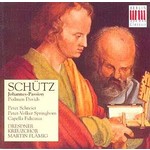
Johannes-Passion SWV 481 / Excerpts from Psalms of David SWV 40 (rec 1972/75)
 $26.99
Out of Stock
$26.99
Out of Stock2-4 weeks add to cart
HEINRICH SCHaƒÅ“TZ
Johannes-Passion SWV 481 / Excerpts from Psalms of David SWV 40 (rec 1972/75)
Peter Schreier (tenor) Peter-Volker Springborn (bass) Gothart Stier (baritone) Fred Maiwald (soprano) / Dresdner Kreuzchor / Martin Fleming / Capella
[ Berlin Classics / CD ]
Release Date: Saturday 1 September 2007
This item is currently out of stock. We expect to be able to supply it to you within 2 - 4 weeks from when you place your order.
"Excellent recordings of Schütz's three passions, featuring the magnificent Peter Schreier as evangelist, in his prime. While the ascetic character of these a cappella works may not appeal to all, they are worth having just to hear Schreier in his element."
(MusicWeb Aug 2001)
Heinrich Schütz was one of Germany's most important composers of the 17th century. Standing at the cross-roads of Renaissance and Baroque music, he profited from a four-year stay in Venice, where he studied with Giovanni Gabrieli, to learn "nuove musiche". This new form was to break with the long tradition of music designed solely to reflect the divine order of things and praise God, and to be more appealing to listeners, through more varied melodies and accompaniments.
Nevertheless, in a period of fecund maturity, Schütz returned to the more traditional style of composing. These three passions all date from the latter decades of Schütz's life - from the period between the late 1640s and the 1660s.
It is useful to put into perspective the role of sacred music in the 17th century. Principally designed to praise God, music was performed in churches by men only. The period up until the 17th century saw music that was essentially an extension of Gregorian chants - a cappella works with vocal soloists, choirs, or a combination of the two. Soloists declaimed more than they sang.
Schütz's passions follow this tradition. Scored for several soloists and choir, they all present the story of the passion, that of Jesus's suffering and death, according to the various gospels that relate this story. As far back as the story of the passion goes, this form of performance seems to have a long history as well. Gospel readings of the passions were probably made as early as the ninth century (if not even longer), when a deacon, priest and subdeacon would read the different parts of the gospel (the evangelist, Christ and the other people) in varied registers.
These passions can therefore be seen as a continuation of an ancient practice, with the difference that choirs are also used. Each of them features an evangelist (Peter Schreier) recounting the story of Christ's punishment and death, in alternation with other characters (Judas, Peter, Pilate, etc.), and a choir.
The St. John Passion, the earliest of the three, written in the 1640s, has the smallest group of soloists, only six. This is also the shortest of the three works, at around 36 minutes. Similar to the other two passions, it can be seen that Schütz had not yet fully established the full range of techniques that would reach their pinnacle in the St. Matthew Passion. Even more spare than the other two passions, this work nevertheless features some excellent choral movements.
Added to the recording of the St. John Passion are four Psalms of David. These earlier works (1619) are totally different than the passions; these are complex pieces featuring double choirs, with varied forms of instrumental accompaniment. Emotive and solemn, these works are much closer to Italian madrigals in their melodic structure and arrangements. Horns float above the voices as the choirs weave arabesques of sound. This is a much different Schütz than that of the passions - here, the music goes beyond the simple emotion of voices to attain a much different effect.
(notes from MusicWeb)
![Matthaus-Passion SWV 479 [St Matthew] (rec 1973) cover](https://images.marbecks.co.nz/_thumbnails/10131/10131412.jpg)

